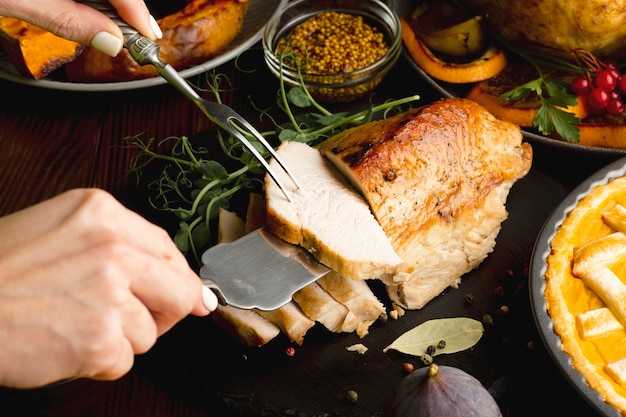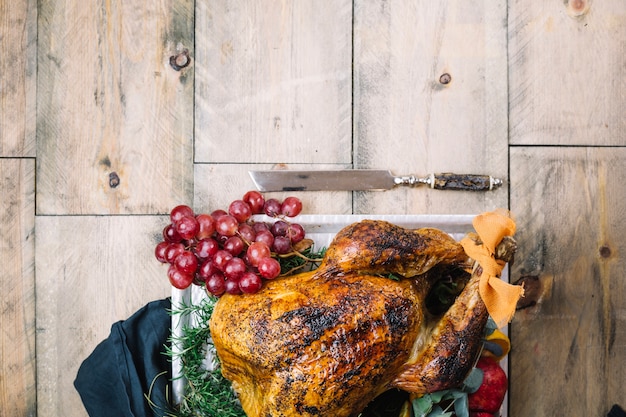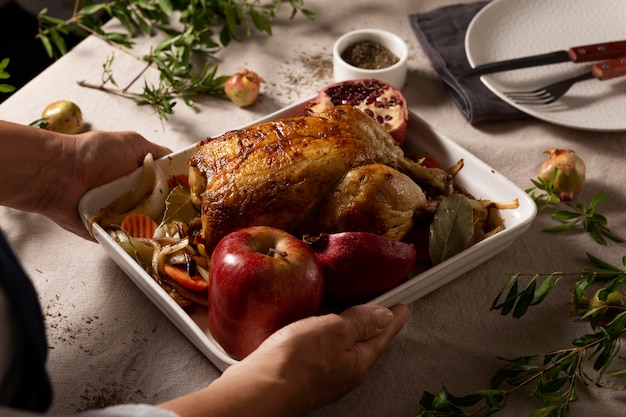Ah, the turkey. The star of the festive feast, the centerpiece of a grand Christmas dinner. But with a 20lb bird, the question inevitably arises: how long do I cook this colossal thing? Now, I'm not a fan of complicated calculations or fancy gadgets. I like to keep things simple, especially when it comes to cooking a Christmas dinner. But, let's be honest, a 20lb turkey is no joke, and a bit of guidance can be a lifesaver.
So, I've put together this guide, a kind of "turkey cooking time calculator" if you will. It's based on years of experience – both triumphant and, well, let's just say there have been a few culinary mishaps. Consider this a starting point, a helping hand, not a rigid rulebook. You'll be fine, I promise. But if you're feeling a bit nervous, there's no shame in double-checking!
Part 1: The Basics of turkey roasting

1. The Bird's Age and Size Matter
First things first, let's acknowledge the obvious: a bigger bird takes longer to cook. It's like baking a giant loaf of bread – you need more time for the heat to penetrate to the core. And, believe me, you don't want a raw turkey at your Christmas table. A 20lb bird is a hefty one, so we're talking about a significant amount of time in the oven.
2. Temperature is Key: Finding the Sweet Spot
You might be tempted to crank up the oven to a scorching temperature, thinking it'll speed things up. But trust me, patience is a virtue here. A high temperature will only lead to a burnt exterior and a raw interior – not a good look for your festive feast. The key is to stick to a steady, moderate temperature, allowing the turkey to cook evenly.
3. The Magic of Roasting: A Gentle Dance with Heat
Roasting, at its heart, is about using hot, dry air to cook the meat. It's a fantastic method for achieving a crispy skin and juicy, flavorful flesh. Imagine it as a slow, gentle process, allowing the turkey to cook from the inside out. And remember, a well-rested turkey is a happy turkey!
Part 2: turkey cooking time Estimates: Navigating the Numbers

1. The General Rule: A Starting Point
Alright, here's the deal: for a 20lb turkey, the general rule of thumb is to cook it for around 3.5 to 4 hours. That's at a moderate temperature, typically around 325 degrees Fahrenheit (160 degrees Celsius). But I always say, "don't be afraid to adjust!"
2. Factors that Affect Cooking Time: Beyond the Basics
Now, there are a few factors that can influence the cooking time. Let's break them down:
- Stuffed vs. Unstuffed: If your turkey is stuffed, add another 30 minutes to the cooking time. The stuffing needs time to cook through as well.
- Bone-in vs. Boneless: If you're roasting a turkey with bone-in legs and wings, it might take a bit longer than a boneless turkey. The bones retain heat, and it takes longer for the heat to reach the center of the meat.
- roasting pan: The size and shape of your roasting pan can also affect how evenly the heat is distributed. A smaller pan might require a longer cooking time.
- Oven: Different ovens can have variations in temperature. An older oven might require a slightly longer cooking time than a newer one.
3. Trust Your Instincts: The Art of Visual Cues
It might sound like a cliché, but trust your instincts. Use your eyes, your nose, and your fingers. Does the turkey look golden brown? Does it smell delicious? Is the meat firm to the touch? If you answer yes to these questions, then you're likely good to go!
Part 3: The Importance of a meat thermometer: Your Culinary Ally

1. A Tool for the Job: Ensuring Safety and Peace of Mind
Let's face it, no one wants to undercook a turkey. That's where a meat thermometer comes in handy. It's not just a fancy gadget; it's a tool that ensures safety and peace of mind.
2. A Safe and Accurate Guide: The Science Behind the Reading
A meat thermometer is your trusty companion in the kitchen. It's designed to give you an accurate reading of the internal temperature of the turkey, helping you determine if it's cooked through. The magic number you're aiming for is 165 degrees Fahrenheit (74 degrees Celsius) at the thickest part of the thigh.
3. How to Use a Meat Thermometer: A Simple Guide
It's really quite simple. Insert the thermometer into the thickest part of the thigh, making sure not to touch the bone. Give it a few seconds to register the temperature, and then check your reading.
Part 4: The Resting Period: Allowing the Turkey to Relax
1. A Crucial Step: Resting for Juiciness
Once the turkey is cooked, don't be tempted to carve it right away! It needs time to rest, to re-distribute the juices and ensure the meat is tender. Think of it like a spa day for your turkey.
2. How Long to Rest: The Time it Takes to Relax
A 20lb turkey should rest for at least 30 minutes, covered loosely with foil. This allows the juices to settle back into the meat, resulting in a more flavorful and juicy turkey. Trust me, the extra wait is worth it!
Part 5: Tips for Roasting a 20lb Turkey: A Step-by-Step Guide
1. Prepare the Bird: Getting Ready to Roast
First things first, remove the turkey from the packaging and pat it dry with paper towels. Next, remove the giblets and neck – they're not needed for roasting.
2. Seasoning and Stuffing: Adding Flavor and Depth
You can choose to stuff your turkey or roast it plain. If you're stuffing, make sure it's cooked separately and then placed inside the bird before roasting. Season the turkey generously with salt, pepper, and any other herbs or spices you like.
3. The Roasting Pan: Finding the Right Vessel
Choose a roasting pan that's large enough to accommodate your turkey. You can use a metal roasting pan or a glass one. Add a few tablespoons of oil or butter to the pan, and then place the turkey inside.
4. Basting is a Good Thing: Keeping the Skin Moist
Throughout the roasting process, it's a good idea to baste the turkey with pan juices. This keeps the skin moist and prevents it from drying out. You can baste every 30-45 minutes.
5. The Final Stages: Checking for Doneness
Towards the end of the cooking time, check the internal temperature of the turkey using a meat thermometer. If it's reached 165 degrees Fahrenheit (74 degrees Celsius) in the thigh, the turkey is cooked.
Part 6: FAQs: Addressing Common Questions
1. Can I roast a turkey at a lower temperature?
Absolutely! If you prefer a slower roasting time, you can cook the turkey at a lower temperature, like 300 degrees Fahrenheit (150 degrees Celsius). Just remember to add more cooking time.
2. What happens if I overcook my turkey?
Overcooked turkey can be dry and tough. However, it's still safe to eat. You can try adding some gravy or pan juices to moisten it up.
3. What should I do if the turkey's skin isn't crispy enough?
If you want a crispier skin, try putting the turkey under the broiler for a few minutes at the end of the roasting time. Just keep a close eye on it to prevent burning.
4. Can I freeze a cooked turkey?
Yes, you can freeze a cooked turkey for up to 3 months. Make sure it's cooled completely and wrapped tightly in plastic wrap or aluminum foil before freezing.
5. How do I reheat a cooked turkey?
The best way to reheat a cooked turkey is in a slow oven at 325 degrees Fahrenheit (160 degrees Celsius). You can also reheat it in the microwave, but it might lose some of its moisture.
Part 7: Some Turkey Cooking Time Table: A Quick Reference
Here's a little table to give you some specific turkey cooking time estimates:
| turkey weight | Cooking Time |
|---|---|
| 10-12 lbs | 2 1/2 to 3 hours |
| 12-14 lbs | 3 to 3 1/2 hours |
| 14-16 lbs | 3 1/2 to 4 hours |
| 16-18 lbs | 4 to 4 1/2 hours |
| 18-20 lbs | 4 1/2 to 5 hours |
| 20-22 lbs | 5 to 5 1/2 hours |
Remember, these are just estimates. The actual cooking time will depend on various factors, including the oven, the size and shape of the turkey, and how well it's stuffed. It's always better to err on the side of caution and check the internal temperature using a meat thermometer.
Part 8: Final Thoughts: A Dash of Confidence and a Pinch of Fun
cooking a turkey can seem daunting, especially if you're tackling a 20lb behemoth. But don't fret! With a bit of planning, a good thermometer, and a dash of confidence, you'll be serving up a delicious and impressive Christmas dinner in no time. Just remember to relax, enjoy the process, and don't be afraid to experiment. After all, a little culinary adventure never hurt anyone, and a successful turkey roast is a victory worth celebrating!
Everyone is watching

How to Cook Frozen Lobster Tails Perfectly: A Step-by-Step Guide
RecipesLobster. Just the word conjures up images of lavish meals, special occasions, and a taste of luxury. But let's...

Pigs in a Blanket Cooking Time: How Long to Bake for Perfect Results
RecipesAh, pigs in a blanket. Just the name conjures up images of those delightful little parcels of crispy pastry en...

Pork Fillet Cooking Time: How Long to Cook It Perfectly
RecipesPork fillet, or tenderloin as it's sometimes called, is a real favourite in our house. It's so versatile, and...

The Ultimate Guide to Tender, Juicy Pulled Pork
RecipesRight, let's talk pulled pork. It's one of those dishes that just screams "comfort food," doesn't it? I mean...

The Ultimate Guide to Cooking Delicious Frankfurters
RecipesLet's face it, we all love a good frankfurter. It's a classic, simple, and always satisfying. But let's be rea...
